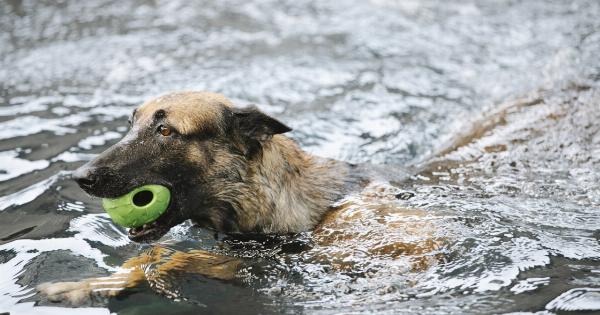Have you noticed your dog sitting in an awkward position lately? Perhaps he seems to be favoring one side or struggling to find a comfortable position. This unusual sitting behavior may be indicative of an underlying issue with his hips.
In this article, we will explore the potential reasons for a dog sitting awkwardly and what you can do to help your furry friend.
Understanding a dog’s normal sitting position
Before diving into the reasons why your dog might be sitting awkwardly, it is essential to understand what a normal sitting position looks like for a dog. Typically, a dog will sit with his hind legs tucked neatly beneath his body.
This position provides balance and stability, enabling the dog to quickly transition into a standing or lying down position. If you notice your dog deviating from this typical pose, it may be worth investigating further.
Possible causes of awkward sitting in dogs
There are several potential reasons why your dog may be sitting in an awkward manner. While it is essential to consult with a veterinarian to get an accurate diagnosis, here are a few common causes:.
1. Hip dysplasia
Hip dysplasia is a condition characterized by an abnormal formation of the hip joint. It is especially common in large dog breeds such as Great Danes, Labrador Retrievers, and German Shepherds.
Dogs with hip dysplasia might have difficulty sitting comfortably due to pain or stiffness in their hip joints.
2. Arthritis
Arthritis is a degenerative joint disease that commonly affects older dogs. It causes inflammation and wear-and-tear of the joints, leading to stiffness and discomfort.
Dogs with arthritis may find it challenging to sit in a normal position due to pain and reduced mobility in their hips.
3. Muscle or ligament injury
If your dog has recently injured a muscle or ligament in his hind legs, he may experience difficulty sitting comfortably.
Injuries such as a torn cruciate ligament or strained muscles can cause pain and instability, forcing your dog to sit awkwardly to compensate for the discomfort.
4. Intervertebral disc disease
Intervertebral disc disease (IVDD) occurs when the discs between the vertebrae in the spine degenerate or become herniated. This condition can lead to pain and nerve compression, which may affect your dog’s sitting posture.
5. Neurological disorders
Certain neurological conditions, such as degenerative myelopathy or spinal cord tumors, can cause hind limb weakness or paralysis in dogs. These impairments can result in difficulties sitting properly.
6. Obesity
Dogs that are overweight or obese may struggle to sit comfortably due to the excess weight putting strain on their joints. Maintaining a healthy weight is crucial to prevent such issues.
7. Pain or discomfort
Remember that dogs cannot express their pain in the same way humans can. If your dog is sitting awkwardly, it could be because he is experiencing pain or discomfort.
Various underlying conditions can lead to such discomfort, and it is important to consult with a veterinarian to identify the cause.
Steps to help your dog
If you suspect that your dog is sitting awkwardly due to a hip problem or other medical issue, it is important to take the following steps:.
1. Consult with a veterinarian
Arrange an appointment with your veterinarian as soon as possible. They will conduct a thorough examination of your dog, including a physical examination, possible X-rays or other diagnostic tests, to determine the cause of his uncomfortable sitting.
2. Follow recommended treatment plan
Upon diagnosing the underlying issue, your veterinarian will suggest a treatment plan tailored to your dog’s specific condition. This could include medications, physical therapy, changes in diet, surgery, or a combination of these.
It is essential to follow the veterinarian’s guidance to alleviate your dog’s discomfort and improve his quality of life.
3. Make environmental adjustments
You can make certain adjustments in your dog’s environment to make him more comfortable. This may involve providing soft bedding, ramps or steps to navigate elevated surfaces, and non-slip surfaces to prevent falls.
Ensuring a warm and comfortable environment for your dog can also aid in managing pain and discomfort.
4. Weight management
If your dog is overweight or obese, working towards weight loss can greatly alleviate the strain on his joints, including his hips.
Consult with your veterinarian to develop a suitable weight management plan that includes a balanced diet and regular exercise.
5. Provide assistive devices
Depending on your dog’s specific condition, your veterinarian may recommend the use of assistive devices such as braces, slings, or wheelchairs to support your dog’s hind legs and provide them with greater stability.
6. Physical therapy
Physical therapy can be beneficial in strengthening your dog’s muscles, improving flexibility, and reducing pain.
Your veterinarian may refer you to a veterinary rehabilitation specialist who can guide you through appropriate exercises and techniques.
Conclusion
If you notice your dog sitting awkwardly, it is important to investigate the cause and seek veterinary care.
While there are several potential reasons for such behavior, including hip dysplasia, arthritis, injuries, or neurological conditions, a proper diagnosis is crucial for effective treatment. With proper veterinary guidance, environmental adjustments, weight management, and potentially physical therapy, you can help your furry companion find relief and live a more comfortable life.






























